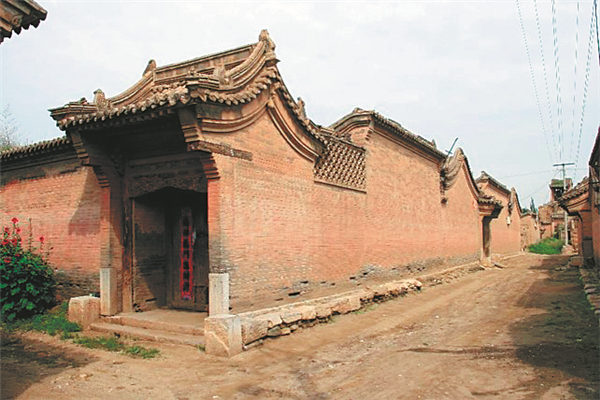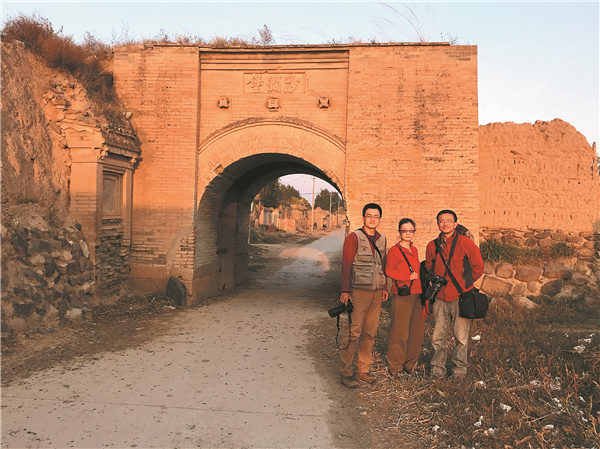
An old residence, featuring traditional eaves and elegant carvings, in Yuxian county, Hebei province, is a fine example of Chinese traditional architecture. [Photo provided to China Daily]
The Great Wall's very name heralds its vastness and its function as a barrier — but zoom in closer on the details, and you'll see there's more to the Wall than, well, just its walls. Amateur archaeologist Cheng Changjin has spent 12 years making over 70 trips to Yuxian county in Zhangjiakou. The over 3,000-square-kilometer county in North China's Hebei province hosts a cluster of Great Wall fortresses built during the Ming Dynasty (1368-1644).
"The county's 796 villages contain 417 castles or forts that still stand, or at least partially remain as ruins. More than 60 others are totally gone," says Cheng, 62.
He adds that rapid urbanization is causing these forts and castles, which are a bedrock of Chinese culture, to vanish from the countryside. And the traditions and history on which they're built are consequently disappearing, too.
"This number of forts and castles is unparalleled in any other county-level region in China," he says.
To preserve them, Cheng and his friends Shang Heng and Guan Qi have visited all the villages in the county. They have snapped more than 1,200 photos and written over 1.5 million Chinese characters to portray a vivid portrait of Yuxian. These records have turned into an eight-volume book that delves into the county's history, architecture and legends.
"Since the past decade has marked Yuxian's period of rapid development, some heritage and relics documented in the book are now gone forever," says Peking University archaeology professor Qi Dongfang.
"As a reader, I am glad they have made their last record in this book."
For Cheng's squad, it is a race against time. Yet they still face many regrets in their field investigations. Cheng explains that the history of some villages has been lost with the passing of the elderly. Some ancient buildings have been renovated and have lost their original appeal. And some murals have been destroyed or stolen due to a lack of effective protection.
"As an amateur archaeologist, I can only make every effort to try to visit every corner of the county to retrace its history as often as I can," Cheng says.
He adds that the book is just a starting point to explore the stories and history of Yuxian.
Shang says that he believes archaeological research always leaves room for regret. Yet, it is this very regret that serves as the driving force for further explorations.
As the late architect Luo Zhewen said: "In the East of the world, there is a miracle of mankind, which is the Great Wall. At the foot of the Great Wall, there is another miracle, that is, the ancient castle in Yuxian county."

A weathered mural in a temple reveals the folk legacy of Yuxian. [Photo provided to China Daily]
Enduring legacy
Known for its historical sites, cultural heritage and customs, Yuxian was a military stronghold that hosted multiple walled-in villages along the Great Wall during the Ming Dynasty. Soldiers were stationed there to guard the region against nomads from the north and cultivated the land when there was no war.
Today, its surviving villages are popular scenic destinations for travelers to learn about the culture of "Chinese castles", and the temples, theaters and old residences that surround them. With traditional eaves and elegant wood, stone and brick carvings, the imposing buildings and courtyards present some of the best samples of Chinese aesthetics.
It stands as a testament to thousands of years of civilization, blending agricultural, nomadic and military cultures, into a unique and enduring folk legacy.
These led to Cheng's "predestined connection" with Yuxian, after he first visited the county in 2007 and watched a show of the 500-year-old performance art dashuhua, which literally translates as "creating tree flowers". Scrap iron is melted to 1,600 C and thrown against a cold wall to create blinding blasts of sparks.
Cheng was an enthusiastic backpacker and began to regularly visit Yuxian. Although he has a busy work schedule as a chemical engineer, he has traveled to visit the county at least once a year, and even once a month during some periods.
He has visited the county 74 times, covering more than 50,000 kilometers and exploring every village nestled within its river valleys and mountain gorges.
"At first, we didn't have map or navigation app. We looked for stone forts to locate these ancient villages, which led us to encounter unexpected history," Cheng says.
As they repeatedly visited these forts and surrounding villages, Cheng came to realize that the county hosts much more than initially meets the eye. Even in newly developed villages or remote mountainous areas, there were unexpected discoveries, such as murals hidden in recently constructed temples.
To further explore the history of these rural settlements and their architectural treasures, Cheng's team has interviewed elderly residents, mostly men older than 60, who likely know more about the local traditions and their respective community's past.
Despite the challenge of understanding the local dialect, Cheng alone has filled more than 30 notebooks recording these conversations.

An ancient earthen village gate still stands to date in Yuxian. [Photo provided to China Daily]
War and peace
Due to the simultaneous existence of military stations for soldiers and fortified civilian settlements during the Ming Dynasty, Yuxian contained an intricate network of defensive structures. Civilians built settlements with advanced defenses to stave off bandits, while soldiers constructed castles to protect national borders from military incursions, as well as other threats. The squad's investigation also uncovered a total of 822 temples in the county, 295 of which contain surviving murals.
Yuxian was a bustling hub in its heyday, but with the advent of modernization and the construction of roads, traffic along the ancient trade routes dwindled, leading to a decline in the county's popularity and economic viability, Cheng's observations suggest.
He is pleased to note that, over the past decade, the local authorities have strengthened the preservation and maintenance of the architecture and murals. Also, villagers' awareness of preservation has improved over time.
Yuxian is known as "a museum of ancient architecture and art in Hebei". The county has more than 1,800 cultural relic sites, 22 of which are under national protection, and 72 varieties of intangible cultural heritage.
However, Cheng still witnesses the disappearance of ancient forts and castles.
So, his journey continues. After all, there remain many secret stories and hidden histories, waiting to be unearthed.

Cheng Changjin (right) and his friends, Shang Heng (left) and Guan Qi, have visited all the villages in Yuxian, Hebei province. [Photo provided to China Daily]
Editor: Song Lifang






